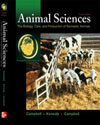
Animal Products |  |
Chapter Summary| The nutritive value of food is a positive factor in determining the health and quality of life from conception until death. Provisions for adequate nutrition in early years contribute to a more productive and enjoyable life in later ones. Most animal products are rich in high-quality protein and relatively low in calories. Animal products also make important contributions to humanity's needs for fats, carbohydrates, minerals, and vitamins. These dietary essentials are available through animal products at a reasonable cost to consumers.
For many centuries domesticated farm animals have made a major contribution to human welfare as sources of food, clothing, transportation, power, soil fertility, fuel, and pleasure. The most important of these is food. Foods from animals are the most nearly complete foods nutritionally. In the United States they provide more than half the dietary protein, calcium, phosphorus, and several vitamins. Animal proteins are of high quality because they contain the amino acids required for human nutrition in proportions similar to those in the human body. Meat and poultry are important sources of iron.
As "natural" foods, animal products effectively balance and supplement plant foods. Meat, milk, and egg proteins are high in biological value and provide essential amino acids often deficient in plant foods. Additionally, milk and milk products are rich in calcium and riboflavin; meats are rich in iron, niacin, and nicotinic acid. Milk and eggs also are important sources of vitamin A. Moreover, animal foods contribute to palatability and variety in the diet of humans.
Improved methods of food preservation increase the availability of animal products, and fortification ensures a more uniform and nutritious product composition. Mixtures of foods from animals and plants, especially fabricated foods, are likely to become more important in the diets of Americans and will provide opportunities for the development of new foods and new menus.
Modern production, processing, packaging, and distribution practices, coupled with close supervision from regulatory agencies, assure today's consumers of having animal products that are safe in terms of disease.
|
|
|